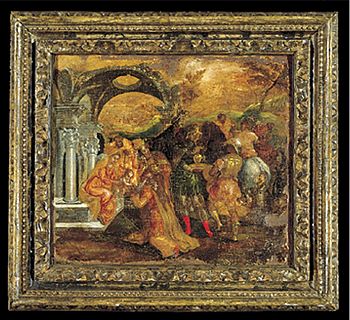I have read a couple of enthusiastic reviews of an exhibition currently showing at New York's Onassis Cultural Center entitled The Origins of El Greco, the last of which was in February's edition of ARTnews. With a subtitle of Icon Painting in Venetian Crete, the show examined El Greco's early work when he, along with a flourishing school of artists, was a Master of religious icon painting in his native Crete in the 1560s. Young Domenikos Theotokopoulos was most skilled in creating shimmering gilt surrounds and stiffly gesturing figures that were part of the Byzantine heritage of Crete.
Adoration of the Magi, Domenikos Theotokopoulos (later known as El Greco), 1565-67, painted on part of an old chest, (Image courtesy of the Benaki Museum,Athens)
It is hard to credit that these early paintings are done by the same artist whom we know as El Greco, the artist whose elongated figures, clothed in strangely coloured garments, twist in religious fervour beneath dramatic skies. Ascetic-looking men with long faces gaze skyward with clasped hands of piety, while impossibly long-limbed men writhe and contort through the paintings. This later El Greco was, as a review of this exhibition by The New York Times' Holland Cotter observed, the result of "an ambitious career on the move" with Venice and later Spain his sources of patronage and success. By the time El Greco died in 1614, his style of painting had evolved radically from a strict medieval icon tradition to an expressionistic approach that embraced light, movement, colour, passion.
The Baptism of Christ, c. 1614, El Greco, (Image courtesy of Museo Fundacion Lerma, Hospital de Tavera, Toledo)
This account of the El Greco exhibition made me reflect on the problem-cum-challenge we all face as artists: how to evolve and grow, and yet remain true to ourselves? The examples of artists who have changed their styles over time are innumerable - Picasso is a salient example, Van Gogh, Gauguin, Monet, and so many others. But in our times of emphasis on marketing and branding, when presenting ourselves to the world as artists, how important is it to have consistency?
There is always the temptation for a successful artist, selling well in one type of art or with one approach and subject, to stay in that idiom, and if a gallery is involved, often there is more pressure to stay in the successful lane. Yet we should all be striving to grow as artists, and by definition, that means change and, hopefully, improvement. Sometimes, repetition of one type of art, one subject or medium, allows for a more profound and rewarding exploration. Yet repetition can become boring and a dead end.
There is also another message, I think, in the El Greco or Picasso examples of evolution as artists. That is that we must believe in ourselves as artists and dare to grow and change, even if it means abandoning a successful style and pathway in one's artistic career. Radical change takes courage. Artist Sharon Knettell, writing in the March 2010 issue of The Artist's Magazine, explained that she gets much of her inspiration for paintings while meditating and remarked, "I think meditation makes you fearless. You have to go to the point where your ideas scare and challenge you" (my emphasis).
I believe that point is when you dare to change your style because that inner voice tells you to take the next step in changing and evolving as an artist. What does anyone else think?

